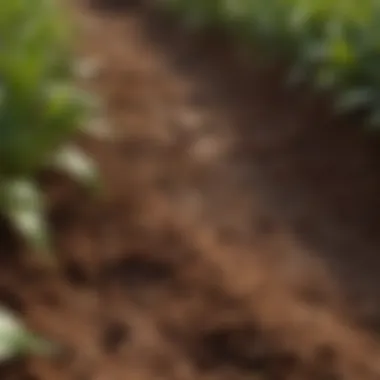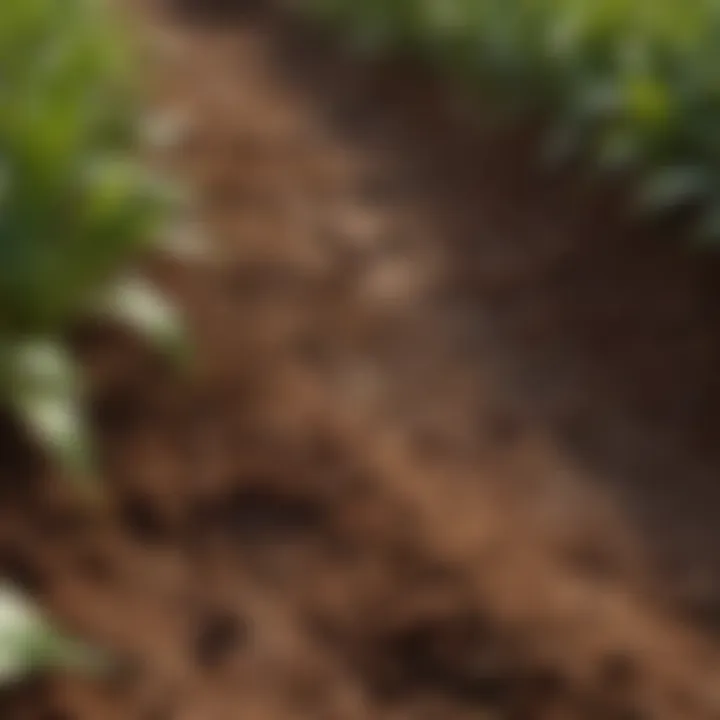Coco Peat Soil Mixture: Boosting Agricultural Efficiency


Overview of the Topic
Definition and Importance
Coco peat, also known as coir pith, is a byproduct of coconut husk processing. It serves as an exceptional soil amendment due to its high lignin content, which contributes to its structure and aeration capabilities. Coco peat enhances water retention, microbial activity, and offers essential nutrients to plants, making it a reliable choice for modern agricultural practices.
The importance of coco peat lies in its ability to improve soil health and promote sustainable farming. As traditional soil resources dwindle, finding alternatives becomes crucial. Coco peat serves not only as an efficient moisture-retaining medium but also as an eco-friendly option, reducing dependence on chemical fertilizers.
Current Trends
Recently, there has been a substantial shift toward organic and sustainable farming. Farmers are increasingly adopting coco peat due to its renewable nature. Moreover, with climate change causing erratic weather patterns, the ability of coco peat to retain moisture has gained significant attention. Various research also highlights its compatibility across a variety of crops such as tomatoes, peppers, and leafy greens, making it a versatile choice.
Key Techniques and Practices
Step-by-Step Guide
- Preparation: Begin by sourcing high-quality coco peat. It often comes compressed in bales, which need to be rehydrated. Soaking in water will expand its volume and improve its structure.
- Mixing Ratios: Depending on the crops and soil type, generally, a 70:30 ratio of coco peat to soil is effective. This can be adjusted based on specific requirements.
- Application: Incorporate the mixture into the planting area. For container gardening, fill pots with the coco peat mixture to ensure optimal drainage and root aeration.
- Monitoring: Regularly check moisture levels. Coco peat can retain water, but it can also dry out quickly if not monitored closely.
Tools and Equipment Needed
- Shovel: For mixing and incorporating the coco peat with soil.
- Water source: To hydrate the coco peat before use.
- Containers or planting area: Depending on the type of farming practiced.
Challenges and Solutions
Common Obstacles
While coco peat presents numerous advantages, there are challenges. Overly high sodium levels in some coco peat products can affect plant growth. Additionally, without proper treatment, it can lead to poor drainage in waterlogged conditions.
Innovative Solutions
Farmers can treat coco peat by rinsing it with freshwater to reduce sodium content. Furthermore, adding perlite or vermiculite can enhance drainage and aeration. Continuous research into proper preparation techniques will support farmers in utilizing coco peat effectively, ensuring its sustained benefits in agricultural practices.
Coco peat is not merely a replacement for soil; it is a holistic amendment that aligns with sustainable agricultural goals. Its role is to integrate into broader farming strategies, enhancing both productivity and environmental stewardship.
Understanding Coco Peat
Coco peat is gaining attention as a versatile soil amendment that can significantly impact agricultural practices. Understanding the origins and characteristics of coco peat forms the foundation for its effective application in farming. Knowledge of its definition, composition, source, and processing is vital for farmers and enthusiasts looking for sustainable solutions in soil management.
Definition and Composition
Coco peat, also known as coir peat, is a natural byproduct of coconut processing. It consists primarily of the fibrous husk of coconuts, which is shredded into a fine, soil-like texture. The composition includes cellulose, hemicellulose, and lignin, making it a rich and organic matter for soil enhancement. Its high organic content helps improve soil structure and quality by increasing the soil's water retention capabilities.
The unique structure of coco peat allows for excellent aeration, which is essential for root health. It has a light, fluffy texture that helps maintain an optimal balance of moisture and air in the soil. Additionally, coco peat is slightly acidic, with a pH level around 5.5 to 6.5, making it suitable for a variety of agricultural applications.
Source and Processing
The primary source of coco peat is the coconut industry. During the coconut refining process, the husk is separated, and this byproduct is what we use as coco peat. While coconuts are widely cultivated in tropical regions, notably in countries like India, Sri Lanka, and Indonesia, the processing of coco peat has also gained popularity as a sustainable practice for utilizing waste materials.
The processing of coco peat involves several steps. First, the husks are soaked in water to soften them. After this, the fibers are extracted, and the remaining material is ground and dried to produce coco peat. The drying process is essential to reduce the moisture content and enhance its shelf life. Often, the processed coco peat is then packaged for sale in large bales or bags.
This transformation from waste to useful product not only minimizes waste but also fosters a circular economy within agricultural practices.
Coco peat’s unique properties stem from both its raw material and the careful methods employed in its production. Understanding the definition and composition, as well as the sources and processing methods, is critical. This knowledge allows farmers to leverage coco peat effectively, maximizing its potential benefits for improving soil health.
Properties of Coco Peat
The study of coco peat's properties is central to understanding its role in agriculture. This natural resource boasts several unique characteristics that enhance soil performance. Its composition impacts water retention, aeration, and overall nutrient profile. By focusing on these elements, farmers and agricultural enthusiasts can leverage coco peat to create healthier and more productive soil environments.


Water Retention Capacity
Coco peat is renowned for its impressive water retention abilities. This feature is crucial for successful crop cultivation. Coco peat can hold moisture similar to a sponge, providing a consistent water supply to plant roots. This capability reduces the need for frequent irrigation, offering significant water conservation benefits.
The ability to retain water helps to mitigate drought stress. When water is scarce, crops can still thrive due to coco peat's moisture-storing qualities. This characteristic is especially vital in regions prone to dry spells. Research suggests that mixing coco peat with traditional soil can improve the overall moisture levels significantly. The water retention ratio typically ranges from 7 to 10 times its weight in water, making it an efficient choice for retaining moisture.
Aeration and Drainage
Another vital property of coco peat is its capacity for both aeration and drainage. Proper aeration is essential for growing healthy plants. Coco peat enhances soil structure by allowing air to circulate. This circulation supports root growth and prevents the problems associated with compacted soil.
In addition to its aeration qualities, coco peat promotes excellent drainage. Excess water can harm plant roots, so a balance of moisture and air in the growing medium is important. Coco peat's fibrous texture prevents water logging, enabling quick drainage. This balance reduces the risk of root diseases and improves overall plant health.
pH Level and Nutrient Content
The pH level of coco peat typically ranges from 5.5 to 6.5, which is ideal for most crops. This slightly acidic nature makes it suitable for various plants, as it allows for optimal nutrient availability. However, it is important to test the pH before use, as variations can occur depending on the source.
Nutrient content is another critical aspect of coco peat. While coco peat itself does not provide a significant amount of nutrients, its ability to retain them is noteworthy. When blended with organic fertilizers, it can enhance nutrient uptake by plants. This synergy helps in providing a balanced nutrition regime for crops.
"Coco peat acts as an enabler for nutrient retention and distribution, fostering improved crop performance."
Benefits of Using Coco Peat in Agriculture
Coco peat has emerged as a significant component in modern agricultural practices. Its unique properties provide numerous advantages for soil health, crop production, and environmental sustainability. Adopting coco peat can enhance not only the agricultural yield but also contribute positively to the environment. This section discusses the multifaceted benefits of using coco peat in agriculture by focusing on sustainability, improvements in soil structure, and the enhancement of crop growth and yield.
Sustainability and Environmental Impact
Coco peat is a byproduct of the coconut industry, which means it is a renewable resource. Utilizing this material helps reduce waste, as it repurposes what would otherwise be discarded. This practice aligns well with sustainable agricultural principles. Given the increase in environmental concerns, the use of coco peat directly addresses issues such as soil degradation and nutrient depletion.
Coco peat contributes to reducing the carbon footprint of farming operations. It requires less energy and fewer resources to produce compared to traditional soil amendments. The transport of coco peat, often sourced from tropical regions, also has less environmental impact when considering its lightweight nature. Farmers can experience a decrease in the use of chemical fertilizers since coco peat provides a sustainable and natural option for enhancing soil fertility.
"Sustainability is not just a choice; it's an essential practice for the future of agriculture."
Improvement of Soil Structure
One of the most considerable advantages of coco peat is its ability to improve soil structure. When incorporated into soil, coco peat enhances aeration and drainage. Good aeration facilitates oxygen flow, which is crucial for root health and microbial activity. This property ensures that crops develop strong root systems, which in turn improves overall plant vigor.
Furthermore, coco peat helps with soil compaction, making it less dense and easier for roots to penetrate. This improvement allows for better water retention and decreases the need for excessive irrigation. Farmers can notice that their land becomes more resilient to drought conditions, providing an edge in fluctuating climate scenarios.
Enhanced Crop Growth and Yield
The benefits of coco peat extend to actual crop performance. Many studies indicate that crops grown in coco peat-based soil substrate experience enhanced growth rates. The improved water retention capabilities mean that crops have better access to water, which is critical during dry periods. This advantage directly translates into increased crop yield.
The nutrient content in coco peat also plays a vital role in promoting healthy plant growth. While coco peat is relatively low in essential nutrients on its own, it has a remarkable ability to hold onto nutrients, making them available to plants gradually. When mixed with organic fertilizers, farmers can witness significantly improved crop yields compared to standard growing mediums.
In summary, coco peat offers several benefits that go beyond mere soil amendment. Its sustainable nature, ability to enhance soil structure, and capacity to boost crop yield make it an ideal choice for modern agricultural practices.
Coco Peat Preparation and Mixing Ratio
Coco peat is a versatile organic material, and understanding its preparation and mixing ratios is essential for maximizing its benefits in agriculture. By carefully selecting, preparing, and mixing coco peat with other soil components, farmers can enhance soil structure, nutrient availability, and overall crop productivity. This section will focus on key considerations for utilizing coco peat effectively.
Selecting Quality Coco Peat
Choosing quality coco peat is the foundation of successful application. Not all coco peat products are created equal, and quality can greatly influence performance. When selecting coco peat, consider the following factors:
- Source: Look for coco peat sourced from reputable suppliers. This ensures that the material is processed and packaged correctly.
- Particle Size: Quality coco peat should have consistent particle size. This consistency aids in water retention and aeration.
- Color and Texture: Dark brown or coconut-colored coco peat, with a crumbly texture, is typically of higher quality. Avoid overly shiny or dry samples, which may indicate poor processing.
- Salt Content: Testing for salt levels is crucial. High salt content can harm plant growth, so choose coco peat with low electrical conductivity (EC).
Preparation Techniques for Use


Once quality coco peat is selected, proper preparation is necessary for its effective use. Preparation involves rehydration, sieving, and mixing:
- Rehydration: Coco peat usually arrives in a compressed block. Soak the block in water for several hours until it expands fully. This process improves moisture retention and reduces the risk of salt toxicity.
- Sieving: After rehydration, it is good to sieve the material to remove large particles, debris, or contaminants. Sieving helps achieve a uniform texture.
- Mixing: Depending on the intended use, additional mixing with other materials may be necessary. Mix thoroughly to ensure even distribution of components.
Optimal Mixing Ratios with Other Soil Components
Finding the right mixing ratio is fundamental to incorporating coco peat into existing soil. Here are some recommended ratios:
- General Mix for Garden Soil: Coco peat can be mixed with peat moss or compost in a ratio of 1:1:1. This balance promotes aeration while retaining moisture.
- For Container Plants: A mixture of 60% coco peat, 30% perlite, and 10% compost is effective for container gardening, encouraging drainage and root development.
- For Seedling Mix: Use a 50:50 ratio of coco peat and vermiculite or perlite, which ensures a light and airy medium suitable for seedlings.
It is important to adjust mixing ratios based on specific crop needs, soil conditions, and local climate. Experimentation with small batches can lead to the most successful outcomes.
Proper preparation and careful mixing of coco peat are essential for the enhancement of soil quality and crop yields.
Integrating these preparation techniques and mixing ratios into your farming practices can maximize the advantages of coco peat. Farmers who pay attention to these details will likely see improved soil health and better crop performance.
Compatibility with Different Crops
The compatibility of coco peat with various crops holds significant weight in the discourse surrounding sustainable agriculture. Understanding how different plants interact with this versatile medium can elevate agricultural practices. By improving soil health and structure, coco peat serves as an enabler of optimal crop growth. When implementing coco peat, farmers must consider specific crop needs, such as nutrient requirements, water uptake, and root system health. This tailored approach enhances overall farming efficiency and productivity.
Vegetables and Herbs
Coco peat is particularly beneficial for a wide range of vegetables and herbs. Its excellent water retention properties ensure consistent moisture levels, which is crucial for the growth of moisture-sensitive crops. For instance, vegetables like tomatoes and cucumbers thrive in coco peat mixtures as they require a well-aerated medium that prevents over-saturation. Additionally, herbs like basil and cilantro gain from the airy structure. This promotes robust root development, which ultimately leads to healthier plants.
Farmers should adopt a mixing ratio that balances coco peat with traditional soil or compost, promoting effective drainage while retaining enough moisture. A common recommendation is a mix of 70% coco peat to 30% organic compost. This blend not only enhances nutrient availability but also incorporates beneficial microbial activity that is necessary for plant health.
Fruits and Berries
When it comes to fruits and berries, coco peat plays a crucial role in maintaining an optimal growth environment. Berries such as strawberries find conducive conditions within coco peat mixtures due to their requirement for well-drained yet moist soil. The pH level of coco peat is typically neutral, which aligns with the preferred conditions for most fruit-bearing plants. This characteristic encourages flowering and fruit-setting.
Furthermore, the ability of coco peat to hold airspaces promotes healthy root expansion, which is vital for fruit-bearing plants. Resilient root systems contribute to the plant's ability to support heavy fruit loads. Incorporation of coco peat in berry cultivation allows for a strategic approach in water management, minimizing the risks posed by drought or overwatering.
Ornamental Plants
The application of coco peat extends to ornamental plants, where it is used to improve aesthetic quality and plant health. Ornamental varieties often require specific care to achieve their visual potential. Coco peat can enhance drainage and aeration, preventing root rot while allowing for the timely removal of excess water, a common issue in potting plants.
Plants like orchids and ferns particularly benefit from coco peat due to their unique water and texture needs. As these plants thrive in environments that mimic their natural habitats—generally moist and well-drained—coco peat fulfills this requirement effectively. By mixing coco peat with bark or perlite, a floral grower can create a potting mix tailored to individual ornamental plant needs. This not only supports their growth but also ultimately bolsters their survival in a controlled environment.
It is important to note that while coco peat is a versatile medium, compatibility depends upon understanding the unique needs of each plant type to ensure successful growth.
Challenges in Using Coco Peat
The integration of coco peat in agricultural practices presents several challenges that must be carefully addressed. While the advantages of coco peat, such as water retention and aeration, are well-documented, it is crucial to understand the limitations and potential drawbacks. Recognizing these challenges is vital for farmers and agricultural enthusiasts who aim to optimize the use of coco peat in their farming systems.
Salt Content Concerns
Coco peat is derived from the husk of coconuts, which inherently contain some salt. When using coco peat, the salt content can affect soil health and crop growth. High salt concentrations can lead to plant stress, inhibit germination, and reduce overall yield. Salt levels can vary based on the processing methods used and the source of the coco peat. To mitigate these risks, it is recommended to test the salt levels in coco peat before application. Leaching the coco peat with fresh water can help to reduce the salt content, thus ensuring a more balanced nutrient environment in the soil.
Quality Variation Across Suppliers
Another challenge in using coco peat is the inconsistency in quality across different suppliers. Coco peat is not a standardized product; its physical and chemical properties can differ based on the manufacturing process. Factors such as the age of the coconut husks, the method of processing, and storage conditions can impact the quality of coco peat. This variability means that farmers must be diligent in sourcing coco peat from reputable suppliers. Conducting tests for properties such as pH, water retention, and organic content before purchase can help in selecting high-quality coco peat, thereby preventing adverse effects on crop performance.
Cost Considerations
Cost can also play a significant role in the adoption of coco peat among farmers. While coco peat is often marketed as a sustainable alternative to traditional soil amendments, the price can be a barrier, especially for small-scale farmers. The initial investment in coco peat, along with transport and mixing costs, can add up quickly. Therefore, farmers should consider the long-term benefits versus initial costs. Additionally, comparing the cost-effectiveness of coco peat against other alternatives like peat moss or compost is advisable. It is also beneficial to explore local suppliers or bulk purchasing options to reduce expenses.
In summary, while coco peat offers valuable benefits for agriculture, addressing these challenges through careful management can enhance its effectiveness in farming practices. Understanding salt concerns, quality variability, and cost implications is essential for successful implementation.


Integrating Coco Peat into Existing Farming Systems
Integrating coco peat into existing farming systems is critical for enhancing soil health and improving crop yield. This section highlights how coco peat can be an effective amendment in various agricultural practices. Its unique properties allow for a smoother fusion with the traditional methods farmers already use. Rather than replacing existing techniques, coco peat is meant to complement them, yielding numerous benefits.
Tillage and Soil Management Practices
Coco peat plays an important role in tillage and soil management practices. By incorporating coco peat into the soil during tillage, farmers can improve soil structure significantly. This results in better aeration and drainage, promoting healthier root growth while increasing the soil's ability to retain moisture.
In terms of soil management, coco peat facilitates moisture retention, reducing the frequency of irrigation required. A well-integrated coco peat mixture can help prevent soil compaction, ensuring a loose and fertile environment for crops. This is especially relevant in areas with heavy clay soils, where traditional tillage often struggles.
Crop Rotation and Intercropping
Coco peat proves to be beneficial in crop rotation and intercropping systems. Since coco peat enhances nutrient retention and offers a balanced pH environment, it encourages diverse planting strategies. Different crops can thrive when grown in combinations with coco peat, resulting in increased biodiversity and pest resistance.
Moreover, using coco peat in rotations allows crops to tap into various nutrients at different soil depths. This not only aids in improving yields but also contributes to sustainable farming practices by enriching the soil over time. Intercropping with coco peat can also lead to improved resource utilization among crops, maximizing the productivity of available land.
Organic Fertilization Techniques
Implementing organic fertilization techniques alongside coco peat can further enhance agricultural outputs. When mixed with organic materials like compost, coco peat contributes to creating a nutrient-rich medium. Its ability to retain water means that nutrients dissolved in water remain available for longer periods, leading to better absorption by plants.
Farmers can utilize a variety of organic waste materials alongside coco peat to promote sustainable practices. For example, kitchen waste or manure can be decomposed on-site and then mixed with coco peat to form an effective fertilizer. This synergy not only reduces waste but also bolsters the nutrient content of the soil.
Future Prospects of Coco Peat in Agriculture
The role of coco peat in agriculture is continuously evolving. As global farming faces challenges like soil degradation and water scarcity, coco peat presents a timely alternative. Its ability to enhance soil structure, improve water retention, and support sustainable farming makes it a pivotal resource. Understanding the future prospects of coco peat is essential for farmers seeking innovative solutions that align with environmental sustainability.
Innovations in Coco Peat Applications
Innovative techniques in the use of coco peat are emerging. Researchers and agricultural practitioners are exploring methods to optimize its benefits.
One notable innovation is the incorporation of coco peat into hydroponic systems. Hydroponics allows for soilless farming, greatly reducing water usage. When used alongside coco peat, these systems can significantly enhance the growth rates of crops. This mix provides necessary aeration while retaining adequate moisture, creating an ideal environment for root development.
Another area ripe for development is integrating coco peat in organic fertilizers. Farmers are experimenting with using coco peat as a carrier for nutrient blends. This not only boosts the nutrient delivery but also contributes to preserving the soil structure.
Furthermore, combining coco peat with various biostimulants is being researched. Biostimulants enhance plant growth and resilience. Studies indicate that plants grown in a coco peat and biostimulant mix show improved root biomass. This innovation suggests the potential for higher yields and better crop health.
Research and Development Directions
The research around coco peat is ongoing and critical for maximizing its potential in agriculture. Several directions are apparent.
First, studies are focusing on improving the processing methods of coco peat. Enhanced processing minimizes the salt content that often affects crop performance. By refining this process, manufacturers can provide a purer product to farmers.
Expanding the scope of compatible crops with coco peat is another vital research avenue. Currently, many crops benefit from its use, but additional studies may uncover new synergies. For example, identifying specific nutrient needs for diverse species can help tailor coco peat applications for optimized results.
Understanding the long-term effects of coco peat on soil health is essential. Research is necessary to establish parameters for its sustainable use. Fertility, microbial health, and organic matter retention are all significant in determining its effectiveness over time.
Ending and Recommendations
The importance of the conclusion in this article is to synthesize the extensive insights provided about coco peat and its applications in agriculture. This section serves as a capstone to the detailed exploration throughout the article, reinforcing the potential of coco peat as a valuable resource for farmers.
A comprehensive understanding of coco peat not only highlights its properties and benefits but also transforms these insights into actionable strategies for sustainable farming. The conclusion emphasizes the role of coco peat in enhancing soil health, improving crop yields, and promoting environmentally friendly practices. Understanding the versatility of coco peat can empower farmers to innovate and adapt their cultivation methods, ultimately leading to more resilient agricultural systems.
Summary of Key Points
- Coco Peat Composition: Derived from coconut husks, coco peat is rich in organic matter, offering excellent water retention and aeration properties.
- Environmental Impact: Utilization of coco peat promotes sustainability by recycling agricultural by-products, thus reducing waste.
- Mixing Ratios: Optimal blending of coco peat with other soil components is crucial for achieving the best results for various crops.
- Crop Compatibility: Coco peat benefits a diverse range of crops from vegetables to ornamental plants, enhancing their growth potential.
- Challenges and Solutions: Awareness of common challenges such as salt content and quality variation helps farmers make informed decisions to mitigate risks.
Practical Recommendations for Farmers
Farmers looking to incorporate coco peat into their agricultural practices should consider the following actionable recommendations:
- Research Quality Suppliers: Not all coco peat is created equal. Identify reputable suppliers who can provide high-quality, salt-free products. Visit community forums like reddit.com for reviews and recommendations.
- Test Soil Conditions: Before integrating coco peat, assess the current soil's pH and nutrient levels. This helps determine the appropriate mixing ratios to use.
- Gradual Inclusion: Start with small quantities of coco peat in your current soil mixture to monitor effects on crop performance before fully adopting its use.
- Monitor Crop Response: Keep detailed records of crop growth and yields after using coco peat. This data can guide future decisions and adjustments.
- Stay Informed on Research: Follow agricultural research developments related to coco peat and its applications. Websites like britannica.com can be valuable resources for updated information.
By following these recommendations, farmers can maximize the benefits of using coco peat, ensuring its sustainable integration into their agricultural practices.



